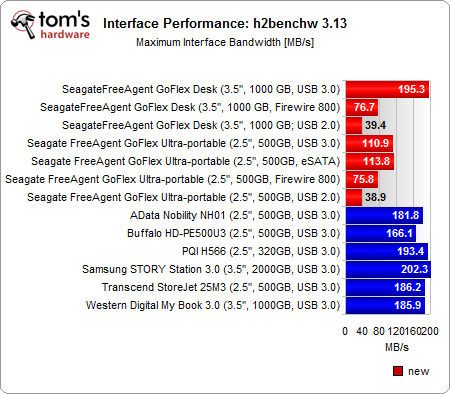Seagate's FreeAgent GoFlex: Modular External Storage
Test Setup And Interface Performance
| System Hardware | |
|---|---|
| Hardware | Details |
| CPU | Intel Core i7-920 (45 nm, 2.66 GHz, 8 MB Shared L3 Cache) |
| Motherboard | Supermicro X8SAX (LGA 1366), Revision: 1.0, Chipset Intel X58 + ICH10R, BIOS: 1.0B |
| RAM | 3 x 1 GB DDR3-1333 Corsair CM3X1024-1333C9DHX |
| HDD | Seagate NL35 400 GB, ST3400832NS, 7200 RPM, SATA 1.5Gb/s, 8 MB Cache |
| Storage Controllers | eSATA: on-board eSATA (ICH10R) USB 2.0: on-board USB 2.0 (ICH10R) USB 3.0: NEC D720200F1 (Gigabyte GA-USB3.0) |
| Power Supply | OCZ EliteXstream 800 W, OCZ800EXS-EU |
| Benchmarks | |
| Performance Measurements | h2benchw 3.13 |
| I/O Performance | IOMeter 2008.08.18Fileserver BenchmarkWebserver BenchmarkDatabase BenchmarkWorkstation BenchmarkStreaming Reads and Writes |
| System Software & Drivers | |
| Operating System | Windows 7 Ultimate |
We compared the GoFlex family and its various interfaces to some of the latest USB 3.0 storage devices.
Interface Performance
This chart shows the maximum throughput of the individual GoFlex interface choices. The USB 2.0 connections are limited to roughly 39 MB/s, which still is a modest result. FireWire 800 will take you to about 76 MB/s, and eSATA or USB 3.0 will unleash the full 2.5” hard drive bandwidth of 110 to 113 MB/s on the Ultra-portable models.
The desktop version could transfer 195 MB/s if the hard drives were fast enough. Keep in mind that this benchmark shows maximum interface throughput, not the throughput off or onto the physical drive.
Get Tom's Hardware's best news and in-depth reviews, straight to your inbox.
Current page: Test Setup And Interface Performance
Prev Page AutoSync Software Next Page Benchmark Results: Read/Write Throughput